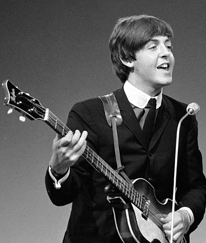
Did you know Paul McCartney didn’t want to play bass?
When the Beatles lost their gig in Germany and were deported back to England, their bass player up to that point, Stu Sutcliffe, didn’t leave with them. He was smitten with a German girl!
But somebody needed to play bass.
John Lennon had a brand new Rickenbacker guitar, while Paul’s had just broke.
George Harrison could pull off their great guitar solos; Paul wasn’t as good.
That left only Ringo but DUH… he’s the drummer! So, voila – a bassist is born!
The Bugera Veyron BV1001T amp sits in my studio due to a similar set of circumstances, and therein lies a tale…
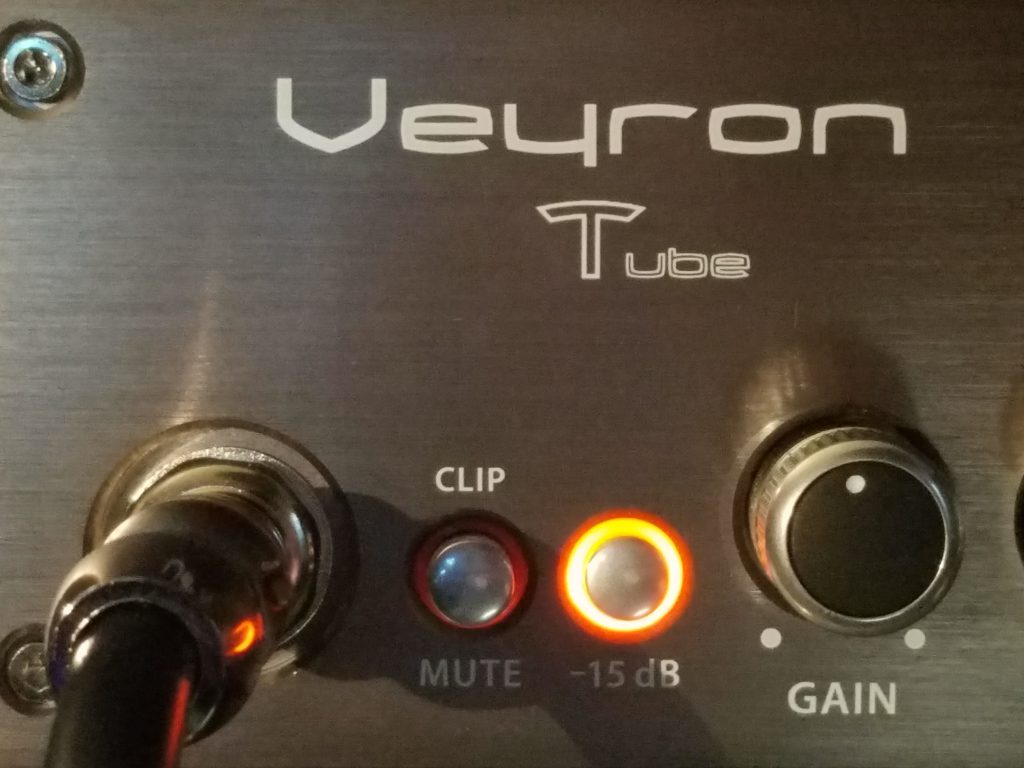
“I’m Fixing a Hole…”
So one day, out of the blue, the bass player in a band I was in said “Hey, for the next three months I’m unavailable. Sorry.”
Great. Don’t you just love it when sudden member departures create a huge hole in your band? It makes things so…so… calm and trouble-free.
NOT!!!!
Anyway, with gigs pretty much every weekend, we needed to fill the gaping vacuum at the bottom of our frequency spectrum. We were gonna have to hire a stranger, or somebody needed to jump in.

Since I had already played bass for years, and already had the gear to prove it, everybody just kinda looked at me. The McCartney moment had struck!
It was no biggie to me, so I said yes. Except for the challenge of learning how to sing my vocal parts while playing the bass lines (which is MUCH different than singing while playing guitar, I’ll have you know!!), I reveled in the opportunity, and ended up enjoying it so much I almost didn’t want to let the old bass player back in! LoL
One big, booming reason? The Veyron amp!
Getting In the (Lava) Flow
Whenever I play live, I take a lot of gear with me. This is mostly because I play multiple instruments and sing, so I’m taking a bunch of electronics that covers a lot of ground!
For this reason, I didn’t want a huge bass head to lug around. I was looking for strong, but ultra-portable and lightweight; with a big voice, but a small footprint.

The Bugera Veyron caught my eye immediately, not only because it fit those criteria of mine, but also because it’s red-orange lava-like glow shown out pretty dang awesome on the music store floor.
Playing it through a cabinet in the store, I found it lacked nothing: punch, clarity, strength, warmth, lots of controls to dial in your tone… it had all that fiery goodness!

At the same time, its Class-D amplification meant there was no heavy power supply or massive heat sink… so it’s the most light-weight bass head I’ve ever played through.
Add to that that it has a gig-ready carrying handle built right into its case and it fits into my Ampeg cabinet like a charm… I was sold!
Which is why I walked out with one.
If you’re interested, this might be the best time for you too as well. Stick to the end of this article for a pretty rare deal I’ll spell out for ya…
“If It Sounds Good… “

“… it IS good!” You’ve heard the truism, and it’s no different with the Veyron T. I chose its sound over other amps made by more “renowned” companies with longer histories ‘cuz nothing else in its price range came even close to sounding as good as this hot licks geyser of tone.
Could you get better sound by spending more money?? Yes, but you’d have to spend a LOT more.
I’ve played this amp live, and in the studio, a lot, and I’ve never come away wanting for anything. Its basic sound is beefy and wide, and the controls allow you to sculpt your own particular groove color easily and quickly.
For under $500?? That’s incredible!!
To give you some idea, I made the video below for you. Nothing beats hearing the real thing, so take a moment and listen to the range of voices available in this beast!
Magma Math
Okay, so… didja like how this amp vented forth some very usable sounds, across a wide spectrum?! That’s the biggest thing I like about it – it’s so versatile.
For those of you all hot and bothered for the specs on the Veyron T though, here they are, by the numbers:

Inputs:
Instrument input: ¼” TS jack,
unbalanced Impedance: 1 MΩ
FX loop return: ¼” TS jack,
unbalanced Impedance (when DI out is pre/post EQ): 20 kΩ / 9 kΩ
Aux input: ¼” TRS jack,
unbalanced Impedance: 10 kΩ
Outputs:
Phones out: ¼” TRS jack, unbalanced
Impedance: 180 Ω
Tuner out: ¼” TS jack, unbalanced
Impedance: 500 Ω

FX loop send: ¼” TS jack, unbalanced
Impedance: 1 kΩ
Direct output: XLR jack, balanced
Impedance: 1 kΩ
Max. level mic / line: Pre EQ (-9 dBu / +12 dBu), Post EQ (-12 dBu / +9 dBu)
Loudspeaker outputs: 2 x locking connector (Speakon)
Min. load impedance: 4 Ω
Footswitch I/O: 1 x 1/4″ (FS-112B footswitch sold separately)
System:

Preamp tubes: 3 x 12AX7
Max output power: 2000 W peak
Power:
Europe/UK/Australia/China/Korea: 220-240 V ~ 50/60 Hz
USA/Canada/Japan: 100-120 V~ 50/60 Hz
Power consumption: @ 1⁄8 max power 110 W
Mains connection: Standard IEC receptacle
Physical:
Dimensions: 293 x 279 x 80 mm (11.5 x 10.9 x 3″)
Weight: 3.2 kg (7.0 lbs)
Comps for the Concert
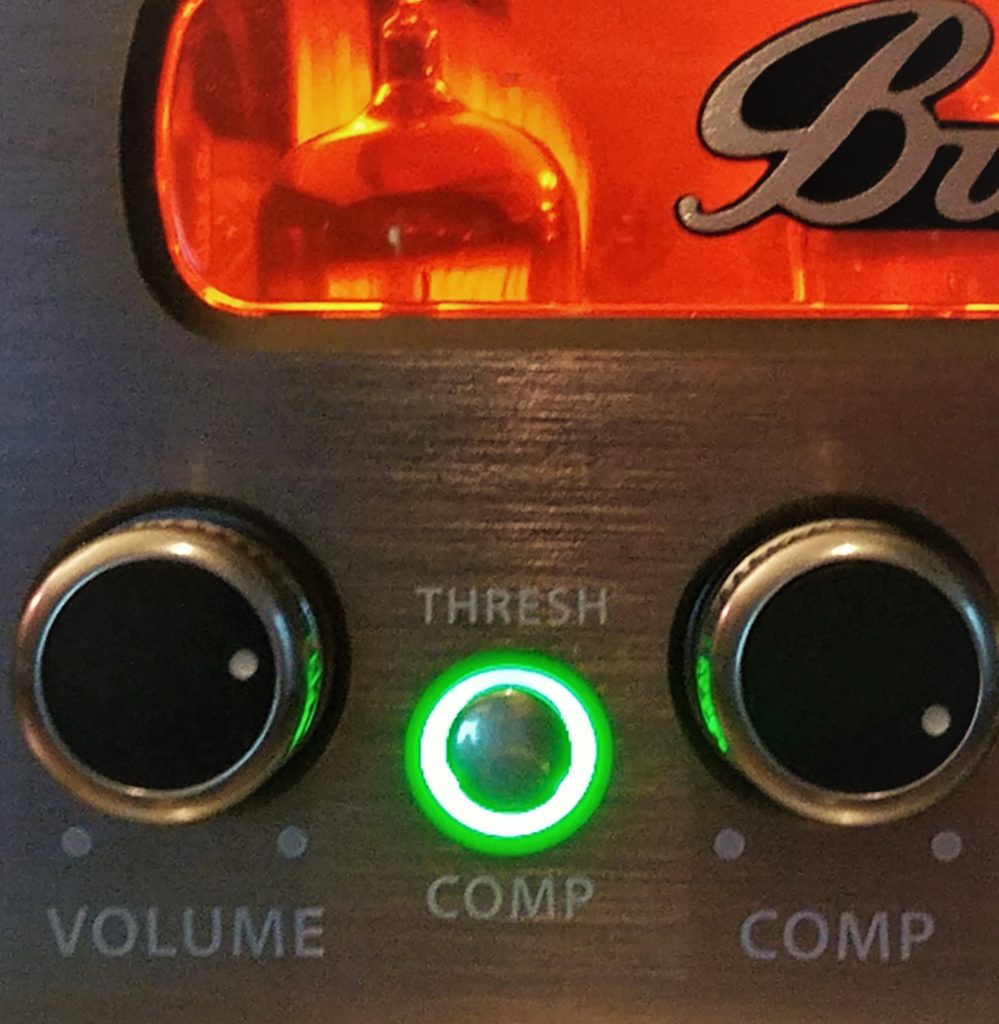
One of my favorite features on the Veyron T is its internal optical compressor. I can’t say enough how unobtrusive yet effective it is. Probably the best internal compressor I’ve ever heard on an amp.
Many times, with amps under 500 bucks, if there is a compressor on board it’s not a very good one. They pump; they breathe; they click. In a nutshell, they’re usually way too noisy and way too obvious.
But our friends at Bugera really came up with a winning processor here. No matter where I set the compressor dial, the tone always sounds extremely smooth and elegant. No artifacts present at all, and there’s nowhere on the dial I need to avoid, like on some lesser amps that I’ve used in my time.
The higher you turn the compressor knob, the more you’re going to have to turn the master volume up. It will definitely affect the total outgoing gain. In other words, there are some pretty high compression ratios available on this baby, but no matter where you set it you can always finesse your total volume with ease using that big red-ringed knob!
When Bugera says in their marketing for this amp that the compression is “studio-grade” I believe ‘em. It does the job in a musical, transparent fashion that compliments your playing style rather than eclipsing it. That’s probably because they modeled the compressor to match a legendary pro audio compressor from the 70s – the Teletronix LA-2A!!

Ring any bells?? If you’ve been involved in professional recording at all, you know that piece of gear. It’s processing and tone to die for.
In fact, I’ve been mixing drums for a song of mine all week, and used this exact emulation on the snare, to make it stand at attention in the mix and give it that extra pro “Oomph!” that separates the newbs from the pros.
The Dynamizer – It’s Gonna BLOW!!

Another way that Bugera has brought in recording studio prowess into this amp is by integrating its “Dynamizer” technology. Basically, it’s funnelling off a second, separate parallel signal off of your main bass signal, heavily compressing it, and then adding it back to your main signal right before output.
Sound familiar? This is the famed “New York compression”, or parallel compression, that has made so many albums sound so amazing over the past decades. To this day it’s used to beef up drums and bass signal… sometimes even vocals. Heck, I’m even using it right now on one of my songs that I’m mixing – that’s how ubiquitous it is!
How cool, then, that Bugera has already implemented this processing into the power management system of the amp itself, so that you get the explosive volcano richness of its technique automatically, without having to deal with any extra channels, knobs or processing.
The detail and powerful punch that you hear in this amp is due, in large part, to this integrated, automatic signal processing.
Way to go, Bugera. Keep those advancements coming!!
Those Hot Lava TUBES!
Okay, so… if you’ve read any of my other posts on guitar amps you know that I’m a tube guy. Yes, there’s a place for solid-state amps in the world. Every once in a while even I want to use one.
But most of the time – not. LoL
One of the biggest reasons I wanted to try this amp in the store was the fact that it came loaded, stock, with three 12AX7 preamp tubes. This is what really delivers the goods.

Bringing the highest voltage gain in their class, these twin-triode vacuum tubes are also known for being low noise. The best of both worlds, in other words.
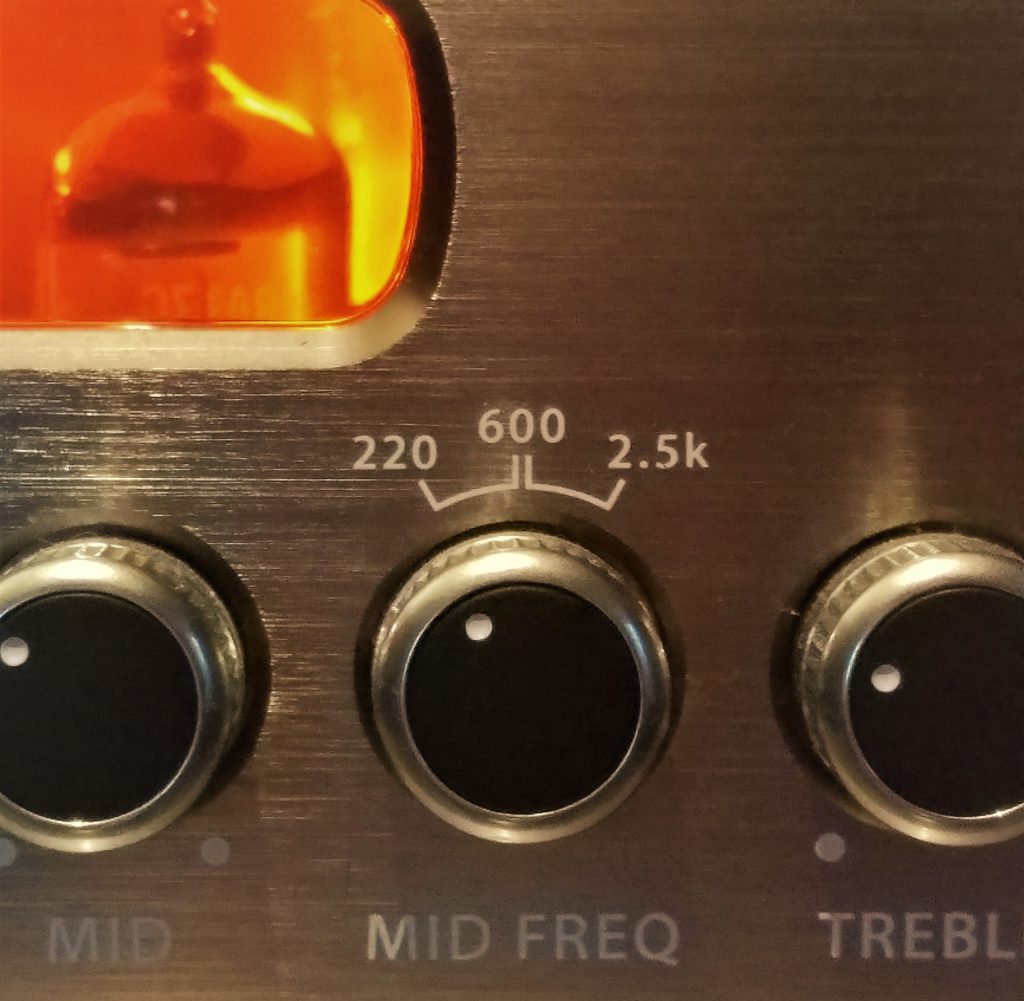
On the Veyron T, the sweepable mid-EQ is also tube-driven. This keeps any Equalization change that you make from sounding too sterile or obvious.
It maintains the warmth and smooth sonic curve of the gain stage signal throughout your entire dynamic range, all while providing exceptional headroom that never trades power for nuance.
There’s a reason why these tubes, first produced in 1947, are still being used by the thousands today for amps and studio gear. You want warm, buttery tone, that can still glisten in the high-end for slap or funk playing?? Or to duck it all down to bottom-end tones that lay a darker foundation with legato lusciousness??!
12AX7 tubes deliver those goods time and again. Just ask any electric guitarist.
But be prepared for them to wax on about it for a while… and on… and on… LoL
A Crater Full of BOOM!!
Okay, let’s just get it right out there: TWO THOUSAND WATTS!!!!
Yes, this amp can pretty much handle anything you throw at it. Now, I know that there are major players rocking it out in huge arenas that will want more than 2000 Watts. I get that.
But I am not one of those. I’ve only played venues that seat a couple thousand, and I’m very happy entertaining those folks, thank you very much.
Maybe one day I’ll need to climb a taller volcano, but for right now… there’s way more power in here than I’ve ever needed.

It says a lot that not one time have I ever heard this amp stutter, gasp or get flabby with my tone. I’ve always played it in the context of a full rhythm section, and it’s always held its own with room to spare.
Two thousand watts.
‘Nuff said.
No Rock-melting Looks from the Sound Mixer!
I’ve worked with a lot of sound people in my day, and they’re all very different. But one thing that is usually the case with all of them is that they want control – control of your sound.
That’s understandable, since it’s their job to make sure that the sound hitting the audience is well-balanced, and rich with clarity and color.
A big plus of the Veyron T is that every sound person I’ve worked with really likes it. The reason? I can send them a direct signal through the XLR port on the back that still allows me, and them, to sculpt the tone in many ways.
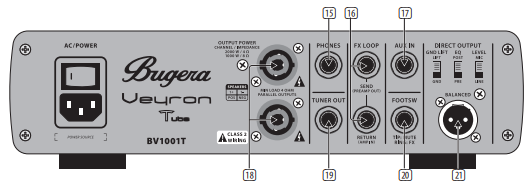
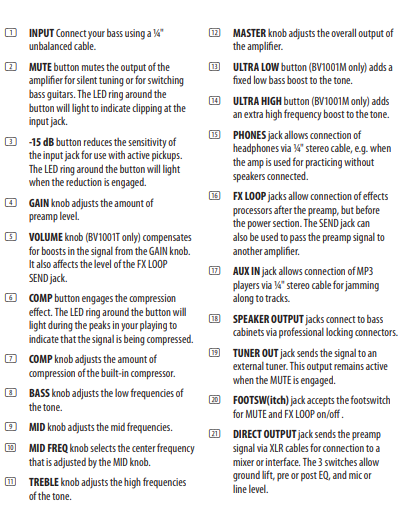
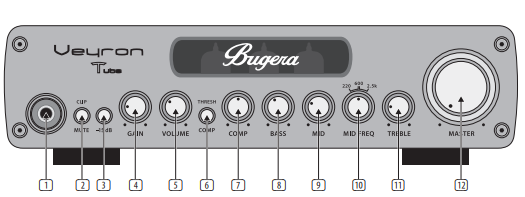
I once sat down for a few hours in the studio and messed with all the direct output switches above the XLR Jack. I couldn’t believe how many shades and nuances of tone I could construct using those switches.
With most amps, you get an output jack and that’s it! No modifiers, no switches. Nada. But with this Bugera amp, I was able to give the sound man exactly what he wanted by adjusting the EQ and changing the switch settings until he said “That’s it!”
And as we all know, if the sound person’s happy, your sound will be happy.
Most of the time, I run the direct output POST-EQ, because I like how I’ve dialed in the sound and the sound person does too.
But there was once when a sound guy wanted the PRE-EQ signal. I acquiesced, ‘cuz onstage I still get to hear my personalized EQ through my cabinet (an Ampeg cab!). Now that’s what I call a win-win!
By the way, here is the “normal” connection method for this amp that I’ve used for all my gigs:
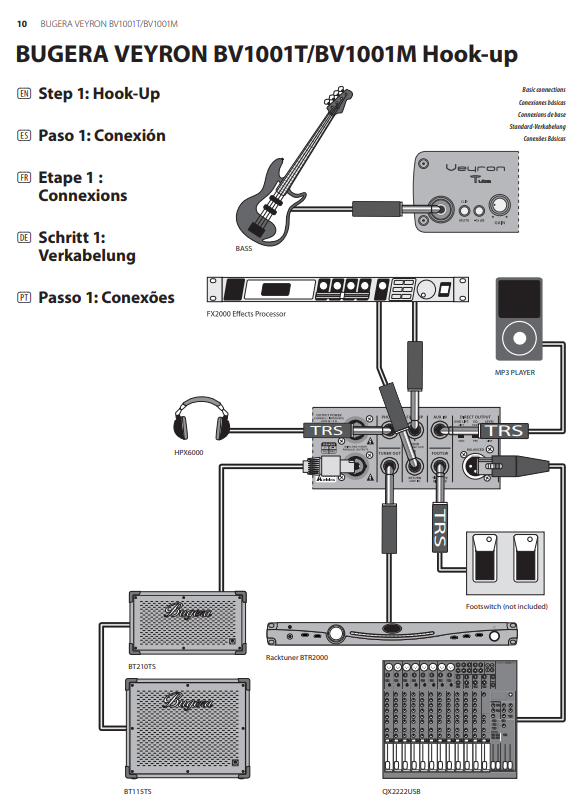
If you’re in the BIG LEAGUES though, you’ll probably want to hear your bass on both sides of massive stages, so for that, you’ll want this configuration:
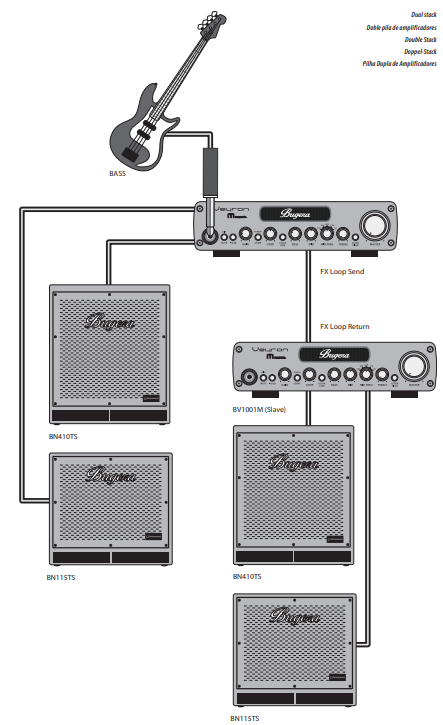
This latter setup demands TWO Veyrons instead of one, but, hey… if you need this setup… something tells me you can afford it!!
The Behringer Connection
In researching for this article, I came across so many differing opinions about who makes the Bugera amps, it was making my strings spin.
So let’s set the record straight, shall we? I did what normal human beings used to do a lot more before social media set in – I called and actually talked to someone. A real live human being. Imagine that! Lol

Leah, who works for “Music Tribe”, a pro audio collective that owns Behringer, amongst several other companies, fielded my call.
She responded professionally and answered all my questions to the nth degree and I couldn’t have received better treatment by a pro audio manufacturer.
You rock, Leah!
Not only did she verify my understanding of the Dynamizer technology that I detailed earlier, she also answered this question:
“Is there a separate company called ‘Bugera’ that makes these amps??”
Her answer? No; there is not. In fact, there never has been. “Bugera” was the name given to a new line of amps manufactured by Behringer when they designed a new radical line years ago.

I read a couple people online saying that Bugera was a separate company once, but they only made speakers for Behringer. Then one day they merged.
According to Leah, that is incorrect. The speakers in their line are made by “Turbo Sound”, which is yet another company owned, though not created, by Behringer since 2012.
To sum it all up, Leah said that basically everything is manufactured in the same huge, quite cutting-edge factory and warehouse in China and then shipped to us here in the States and other countries abroad.
Now, I’ve been in the music business for decades. I know the bad rap Behringer has had in the past. All I can say is that this Veyron T amp has worked flawlessly for me for three or more years now, both in live and studio settings.
It’s this type of dependability that we look for in our audio gear. Maybe that’s why Behringer continues to grow as one of the largest manufacturers of music products in the world today.
If my Bugera Veyron head is the kind of product Behringer creates, then I’ll just put it simply…
Consider me a fan.
Cause Your Own Eruption!
We hope you’ve enjoyed our look at the Bugera Veyron T today. Since it’s a huge part of my primary bass rig, I’m sure you could sense “the love”.
If you want a big 2000 Watt volcano of sound, with lots of headroom, and the warmth of tone that 12AX7 tubes always bring to the amp equation, all for under $500… you won’t find a better option than the Bugera Veyron T.
Amazon, Musician’s Friend, and Guitar Center all offer “no-questions-asked” return policies, so for more information about this exceptional amp head and to check availability, just CLICK THIS LINK or any of the others above.
But wait! I mentioned a “rare deal” earlier for you. Here it is: for some inexplicable reason, Amazon is (as of TODAY at least) selling this unit for a HUNDRED BUCKS LESS than Musician’s Friend OR Guitar Center! That’s huge!!
I have no idea why, or if it’s a mistake they haven’t caught, or how long it’ll last, but, man… if you want to play this amp like I do, I’d be jumpin’ on Amazon pronto. You don’t often find a hundred bucks off music gear!!
Alright, so… go tear up that bottom end. In the meantime, you know where I’ll be…
Playing through my Veyron!!
Now, go… make… sounds!!
Teaj





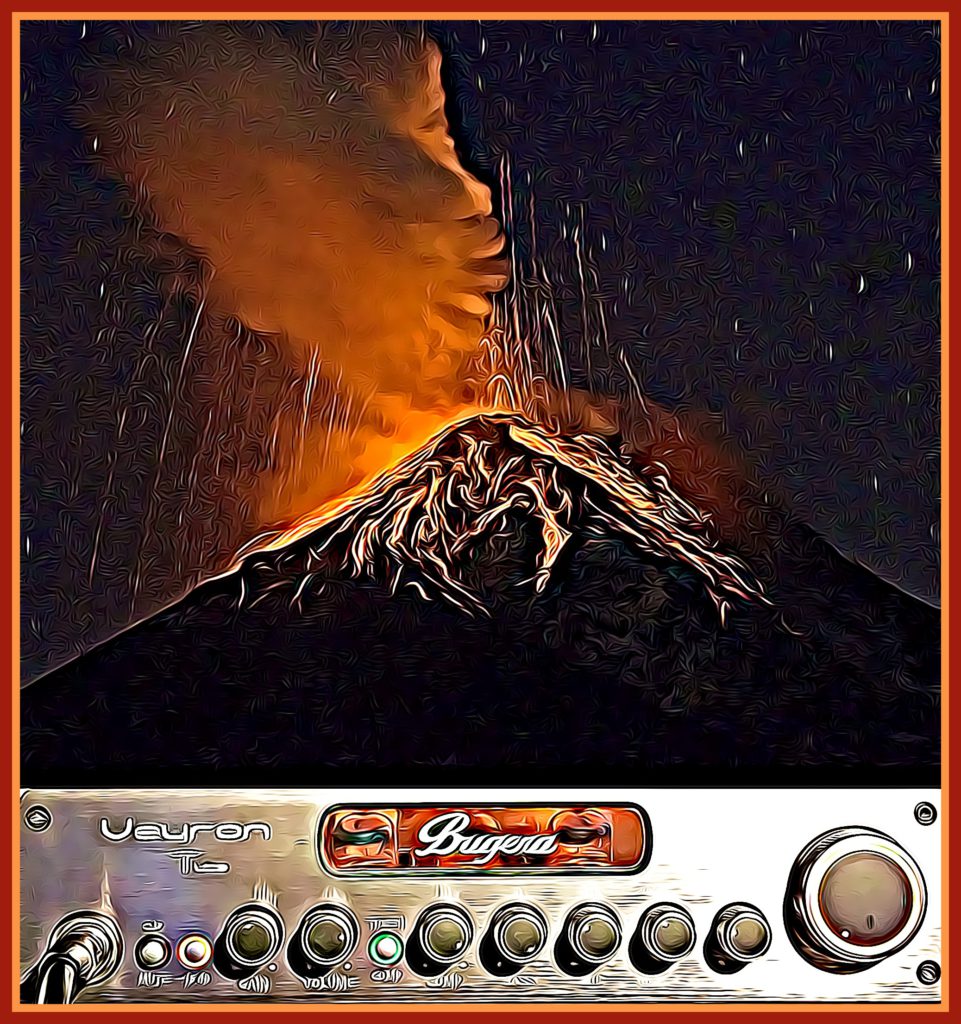

Can’t say I’ve seen anyone actually “testing” this amp. I CAN say, though, that it’s never showed any weakness for any cabinet I’VE put it through.
Plus… I just love how COOL the dang thing LOOKS. Definitely an “ooooo…” factor there! LoL
Nice blog here! Also your site loads up very fast! What host are you using? Can I get your affiliate link to your host? I wish my web site loaded up as quickly as yours lol
I’ve had my BV1001M for over 3 years and it has performed well. However, the old adage “too good to be true” is what comes to mind and especially for the $400 price in 2018.
I still cannot believe it produces the power it has been said to: 2000 watts @4 ohms or 1000 watts @8 ohms. Can you point me to an independent test that shows the actual wattage and not just repeat what the marketing department states?
I am not dissing the amp, I just want to know the truth. TIA.
Yep, Josie… that’s why I bought it!! LoL
You play?? Or wanting to?? I ask ‘cuz we just published THIS BASS GUITAR ARTICLE on how to choose your first bass. It’s got some CRAZY GOOD prices in there… !
I actually had no idea that Paul McCartney didn’t want to play bass, or how he ended up with that role, but aren’t we so lucky that he ended up doing so!? Thanks for this recommendation also – quality product at a great price and suitable to use in a wide variety of situations. Exactly what’s needed!